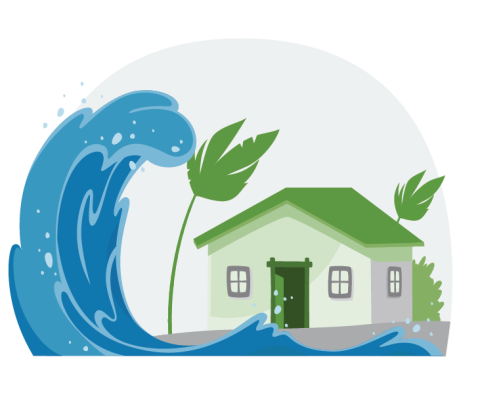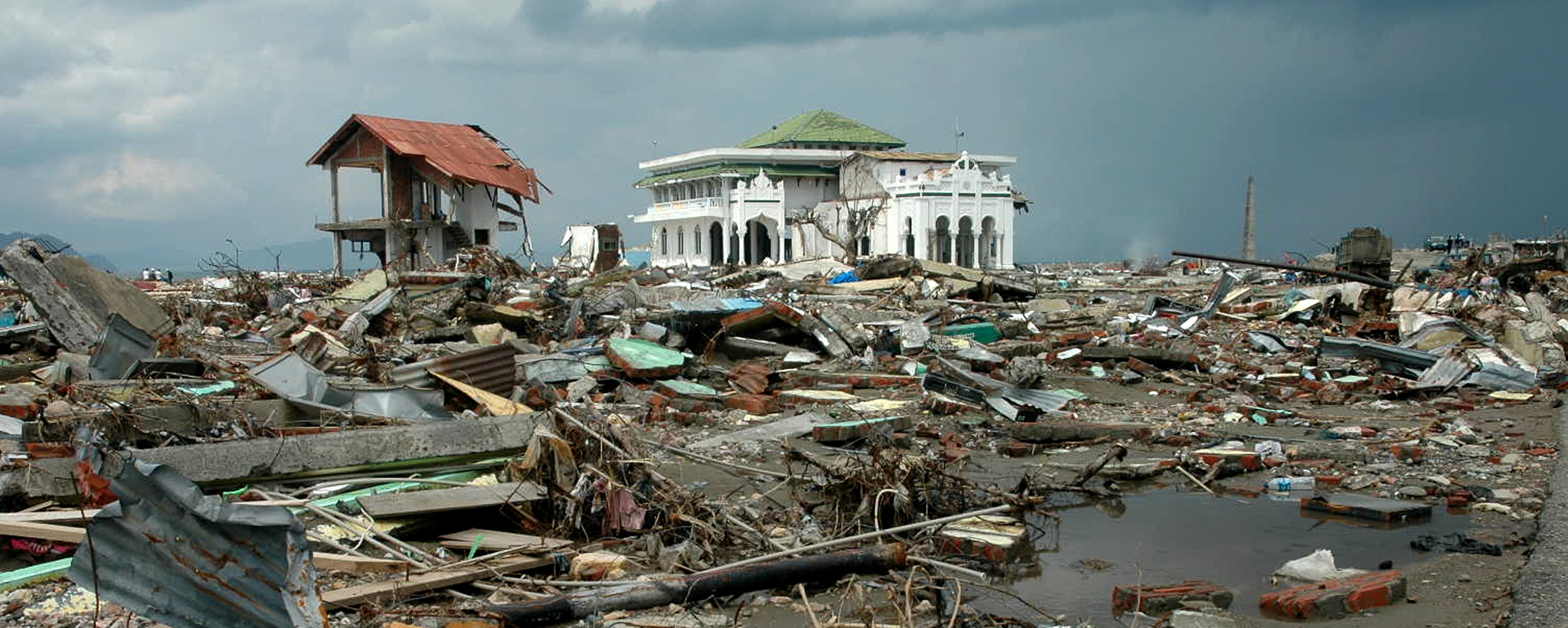Words to Know
Am I at Risk?
What Can I Do?
Learn More
A tsunami (pronounced soo-nahm-ee) is a series of waves (not just one) caused by a large and sudden disturbance of the sea. Tsunami waves move outward in all directions from where it started. They can move across entire oceans. As the big waves approach shallow waters along the coast, they grow to a great height and smash into the shore. They can be as high as 100 feet. They can cause a lot of damage on the shore.
Most tsunamis are caused by undersea earthquakes. However, they can also be caused by landslides, volcanic activity, and even meteorites. Not all earthquakes cause tsunamis.
Words to Know
Debris - Rubble, trash, or random material such as large pieces of wood, metal, or plastic.
Inland - Away from the coastline.
Evacuation - Leaving an area that has been declared unsafe.
Seismic Sea Waves - Another way to describe tsunamis.
Am I at Risk?
Tsunamis generally appear in the Pacific Ocean and coastal areas. Hawaii is the state at greatest risk for a tsunami. They get about one a year, with a damaging tsunami happening about every seven years. Alaska is also at high risk. Coastal states, like California, Oregon and Washington experience a damaging tsunami about every 18 years.
Tsunamis can strike any U.S. coastline. Areas within a mile of the shoreline and areas less than 25-feet above sea level are at greater risk. Tsunamis generally appear in the Pacific Ocean and coastal areas. Hawaii, Alaska, Washington, Oregon, California, and the U.S. Caribbean islands are at greatest risk for a tsunami.
What Can I Do?
Before

- Build an emergency kit with items that you will need in case you need to evacuate quickly.
- Make a family communications plan. Review evacuation routes and sheltering in place guidelines during a pandemic.
- If you see the water pull back from the shore out to sea very quickly, get away from the area immediately.
- There are four levels of tsunami alerts issued by the tsunami warning centers for United States and Canadian coastlines:
- Tsunami Warning: Take Action—Danger! Follow instructions from local officials. Evacuation is recommended. Move to high ground or inland (away from the water).
- Tsunami Advisory: Take Action. Stay out of the water and away from beaches and waterways. Follow instructions from local officials.
- Tsunami Watch: Be Aware. A distant earthquake has occurred. A tsunami is possible. Stay tuned for more information. Be prepared to take action if necessary.
- Tsunami Information Statement: Relax. An earthquake has occurred, or a tsunami warning, advisory or watch has been issued for another part of the ocean. Most information statements indicate there is no threat of a destructive tsunami.
- Listen to evacuation orders and leave the area immediately if told to do so.
- Take any pets with you.
- Move inland (away from the ocean) and towards higher ground.
- Stay away from the beach. Never go down to the water to watch a tsunami come in. If you can see the wave, you are too close to escape it.
- If you see the water pull back from the shore out to sea very quickly, get away from the area immediately.
- Move to the upper levels of a tall, fortified building to minimize your hazard exposure.
During
- Listen to evacuation orders and leave the area immediately.
- Take any pets with you.
- Move inland (away from the ocean) and towards higher ground.
- Stay away from the beach. Never go down to the water to watch a tsunami come in. If you can see the wave, you are too close to escape it.
- If the water recedes from the shoreline or goes out to sea in a very noticeable way, get away from the area immediately. This is nature’s warning that a tsunami is coming.
- Move to the upper levels of a tall, fortified building to minimize your hazard exposure.
After

- Don’t return home unless officials tell you it is safe to do so. Tsunami waves can continue for hours and the next wave may be more dangerous than the first.
- Stay away from debris in the water. It could be dangerous.
- Carefully watch every step you take. Stay away from debris in the water. It could be dangerous because it could contain harmful chemicals or may be electrified by downed power lines
- Stay out of any building with water around it. Water can make floors crack or walls collapse.
- Text, don’t talk. Unless there’s a life-threatening situation, send a text so that you don’t tie up phone lines needed by emergency workers. Plus, texting may work even if cell service is down.
- Be very careful before re-entering your home or other buildings. Tsunami-driven floodwater has likely damaged the building in many ways that you can’t see. Be sure a parent or adult is with you.
- Know that it’s normal to feel anxious or stressed out. Everyone reacts differently to stressful situations. Take care of your body and talk with your parents or other trusted adults if you are feeling upset.
Learn More
Did you know?
“Tsunami” is a Japanese word. Tsu means “harbor” and nami means “wave.”
On the open spaces of the ocean, a fast-moving tsunami may only be a few feet high, with 100 miles separating wave crests. As they approach shore, waves increase in height and currents intensify, which create a bigger threat to life and property.
Few tsunamis “break” like the waves seen in wind-generated waves popular with surfers. Tsunamis are more often associated with strong currents and walls of water that do not retreat like normal tidal waves do.
Tsunamis may be local, regional, or far away. The type of tsunami depends on the location of where the tsunami started and where it may hit land.
Learn more at:


